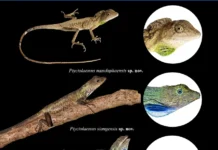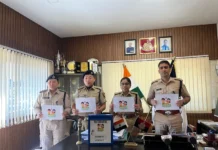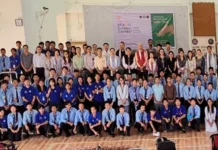[Karyir Hakom, Genam Nobeng and Nongthombam Devachandra]
Being an introduced exotic fruit, dragon fruit does not have any vernacular name in any of the dialects in Arunachal Pradesh. Dragon fruit, known by many names viz. pitahaya, strawberry pear, Jesus in Cradle etc., is one of the most popular fruits in recent time. Though the name suggests China in some way or the, other, but it is native plant of Central and Southern America. Belonging to cactus family, it is a semi-epiphytic herbaceous plant with climbing habits. Emergence of aerial roots are common feature. It is acknowledged as a ‘super fruit or food’ because of its numerous health benefit properties. It is acknowledged that the fruit was introduced in the state during 2018 in Nianu village in Longding circle by KVK (Longding district). Thanks to the tireless efforts of the state department of horticulture as well as extension services rendered by ICAR, Basar, College of Horticulture and Forestry, Central Agricultural University (Imphal), Pasighat, and their KVKs; dragon fruit is being adopted in large scale in recent time by the farmers and horticulture enthusiasts alike in the state.
ICAR has given an Indian name to this exotic fruit as Kamalam! Arunachal Pradesh, on account of having tropical agroclimatic condition in foothills, large scale commercial cultivation of Kamalam is said to be possible. Pink or red skin-white flesh (Hylocereus undatus); Red-skin purple flesh (Hylocereus costaricensis); Pinkish-skin red-flesh (Hylocereus polyrhizus) and yellow skin white flesh (Hylocereus megalanthus); Red skin red pulp (Hylocereus purpusii) are more preferred by consumers, thereby the growers. However, locals like fellow Asians prefer red flesh fruits. Interestingly, European market is dominated with white flesh dragon fruits.
Nutritional Value
Dragon fruit is low in calories and rich in antioxidants, making it a good addition to any weight loss diet. Pulp of this fruit is rich in vitamins such as A, B (niacin, riboflavin), C, and E. Fruit pulp is also rich in antioxidants. Consumption of this fruit ensures sufficient supply of minerals like iron, potassium, calcium, magnesium, and zinc. Seeds are reported to be rich in omega-3 and omega-6 fatty acids that reduce triglycerides thereby lower the potential risk of cardiovascular disorders. Fruits can be processed into juice or wine.
Health Benefits
Many researchers have confirmed the significant health benefits of consuming dragon fruits. These include protection from prostate cancer, improves digestion, improves appetite, relief from constipation, enhancing immune system, prevent diabetes, improves functioning of brain and heart, makes bone stronger, controlling blood cholesterols, improve respiratory disorder like asthma, slow-down ageing, improves vision, accelerate healing of wounds, avert acne development, enhances skin health, relief from arthritis pain, and prevent anaemia. Therefore, we should encourage consumption of this fruit as and when they are available in the markets at affordable price.
Some of the important aspects for commercial cultivation of dragon fruits that need to be considered may be enlisted as hereunder:
Always consult horticulture development officers at different district of the state, KVKs, ICAR (Basar), College of Horticulture & Forestry, Pasighat for quality planting materials and varieties.
Identification and selection of suitable site that receives ample sunshine and well drained soil. However, scorching sunlight or extreme shading is detrimental for dragon fruit.
Training system: Provision for supporting structure (Cemented pillar with overhead ring; wooden or bamboo structures with tyres on top of them). Three to four plants can be adjusted near every pillar.
Planting time is June-August with 2 or 3 m × 2 or 3 m.
Intercropping with locally preferred vegetables especially during the initial years of planting. It is advisable to avoid excessively water loving intercrops as dragon fruit performs to its best under xerophytic growing conditions.
Though a rain fed crop, quality fruits with higher yields are obtained when supplementary irrigation is arranged especially during prolong dry spell (May-July and October–January)
There had been no serious reports of pests and diseases in dragon fruit. However, in nurseries the cladodes (the green leaf like stem structure) are sometimes observed to be infested by caterpillars and infected by fungi and bacteria.
Generally, seed as planting material takes 5 years (approx.), however with cuttings as planting material it takes 14-16 months and therefore cuttings are more preferred by the growers. The first flowering and fruiting of the year comes during April (in irrigated garden) or May (rain fed garden). Fully ripen fruits are generally ready for harvest after 30–45 days after bloom. Hence, growers harvest the fruits during May (early summer) and continues up to November (early winter). Four to six staggered harvesting is possible during this fruiting period yielding around 20–30 kg per pole (3–4 plants). In Arunachal Pradesh this ‘Super Fruit’ is prominently cultivated in the Toru Circle of Papum Pare district, particularly in Kheel village.
Conclusion
It is fortunate enough that the Department of Horticulture, Govt. of Arunachal Pradesh, ICAR-NEH Mizoram Centre, Basar as well as College of Horticulture and Forestry, CAU(Imphal), Pasighat and their KVKs recognize Kamalam as a potential fruit crop for the state. Establishment of nursery, commercial cultivation, trading of fresh fruits or processing of dragon fruit- all these ventures could result in prosperity of the farmers in coming years. Both for domestic consumption as well as targeting markets in other states may be emphasized as long-term vision. With the production of larger volume of fruits, even the price of fruits would be quite affordable for all classes of consumers beyond the wealthy consumers. Fresh fruits and juices can be enjoyed during the summer days, while Kamalam wine can also be explored.
[Karyir Hakom and Genam Nobeng are B.Sc. (Hons) Horticulture, 3rd Year students while Nongthombam Devachandra is Assistant Professor (Fruit Science), College of Horticulture & Forestry Central Agricultural University, Imphal (Pasighat)].





